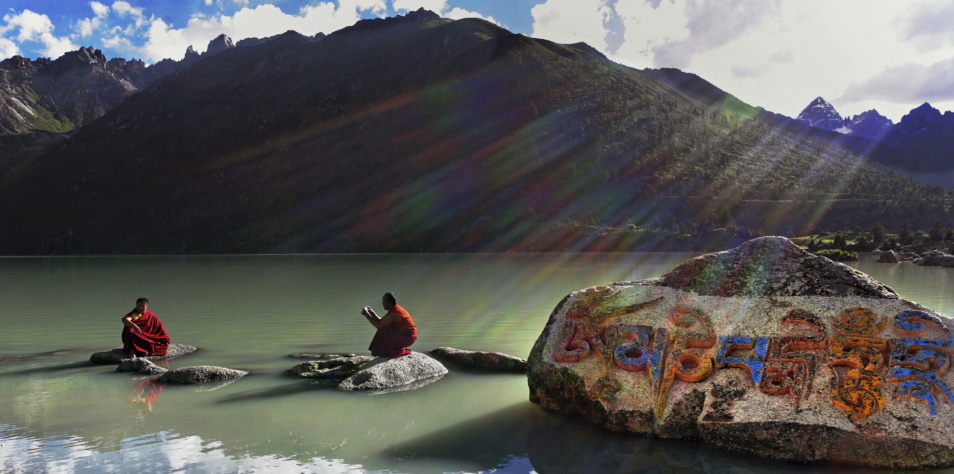#3 – April 2013 Newsletter
In this edition:
- Teacher’s news: Dilgo Khyentse Yangsi Rinpoche and Shechen Rabjam Rinpoche
- Report and photos of annual drupchen ceremonies & tsechu tsam
- Annual graduation ceremonies
- New monks admittance
- Nuns trained as solar engineers install solar panels in Nepal.
- Transmission of Mipham Rinpoche’s texts bestowed in Bodhgaya
Shechen Rabjam Rinpoche News
In early March 2013, Shechen Rabjam Rinpoche began an extended meditation retreat. Rinpoche is in good health and we rejoice that he has this opportunity to enter retreat.
Dilgo Khyentse Yangsi Rinpoche has suggested that students and friends join the Shechen Sangha in reciting long life prayers and making aspirations for the fulfillment of Rabjam Rinpoche’s Dharma activities for the benefit of all beings. Activities at Shechen Monasteries and Nunnery will, of course, continue as usual. Long life prayer .
Dilgo Khyentse Yangsi Rinpoche’s Activities
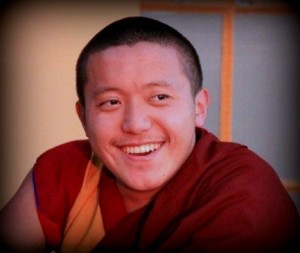 This has been a busy year for Dilgo Khyentse Yangsi Rinpoche. He suspended his private studies in Bhutan with Khenpo Yeshe Gyaltsen in order to attend a three-month series of empowerments of the Damngak Dzo given by Dzongsar Khyentse Rinpoche in Bir, India. When they were finished, he went straight to Bodhgaya for the annual Nyingma Monlam, which was followed by the oral transmissions of the entire collection of teachings and practices by Lama Mipham Rinpoche. This precious transmission was bestowed by Shechen Rabjam Rinpoche, details of which you can read in a separate article below … (read more)
This has been a busy year for Dilgo Khyentse Yangsi Rinpoche. He suspended his private studies in Bhutan with Khenpo Yeshe Gyaltsen in order to attend a three-month series of empowerments of the Damngak Dzo given by Dzongsar Khyentse Rinpoche in Bir, India. When they were finished, he went straight to Bodhgaya for the annual Nyingma Monlam, which was followed by the oral transmissions of the entire collection of teachings and practices by Lama Mipham Rinpoche. This precious transmission was bestowed by Shechen Rabjam Rinpoche, details of which you can read in a separate article below … (read more)
After the Tibetan New Year, Rinpoche returned to Nepal to attend the annual drupchens and sacred dances. In late March, he traveled to Maritika Long Life cave with a number of Shechen tulkus and 25 monks to lead the Pema Tse Ningtik Drupchen, a terma practice of the previous Khyentse Rinpoche.
In mid-April, Khyentse Yangsi Rinpoche will be teaching at the Shechen Center in Croatia. Senior teachers from Shechen Monastery will join him in presenting the seminar curriculum. This teaching is part of an ongoing series of the annual teachings held in Bodhgaya and Croatia. The teachings are not public and are given only to those students who have taken on the practice commitment. Rinpoche will then return to Bhutan to continue his own studies for the remainder of the year.
Annual Drupchen Ceremonies and Tsechu Cham
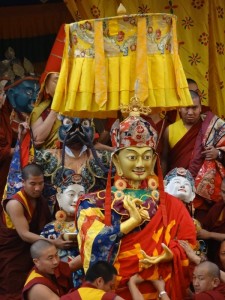 Annually in the “Miracle Month” Shechen Monastery in Nepal welcomes the Tibetan New Year with drupchens and other ceremonies to purify obstacles and invoke blessings, harmony, and auspiciousness.
Annually in the “Miracle Month” Shechen Monastery in Nepal welcomes the Tibetan New Year with drupchens and other ceremonies to purify obstacles and invoke blessings, harmony, and auspiciousness.
The Minling Dorsem Drupchen and the Tsokchen Dupa Drupchens have been performed every year at Shechen Tennyi Dargyeling in Nepal since its main temple was built in the early 1980’s. In 2010, the year of the centenary of the birth of Dilgo Khyentse Rinpoche, Shechen Rabjam Rinpoche introduced four more drupchens. These are conducted at the same time as the Tsokchen Dupa in different temples in the monastery. The five ceremonies, known as the “Five Ka’ma Drupchens”, are performed according to Dilgo Khyentse Rinpoche’s original vision.
Drupchen means “great accomplishment” and is a form of intensive group practice that embodies the essence of the Vajrayana. It combines a range of skillful methods including ritual, and sacred arts to invoke the enlightened nature that is the essence of all beings. During the seven or ten days of the drupchen retreat, practitioners continuously perform the sadhana (means of accomplishment), offer the tsok (feast), and recite the drupchen prayers and mantras in shifts so that they are recited continuously for 24 hours.
By practicing the sadhana actualized through visualizations, mantra recitation, and meditation, habitual perceptions are transformed and purified into their true and sacred nature. Everything is seen and experienced in its pure nature: ourselves as a buddha and our surroundings as a pure realm.
Participating in this powerful practice is regarded as bringing the same benefit as practicing during several years in solitary retreat. It helps the practitioner to train in pure perception, and sharpens their ability to perceive the environment as a Buddha realm.
At the conclusion of the drupchens cham (sacred dances) are performed in the courtyard of the monastery. The monks train throughout the year for this annual ceremony in which Khyentse Yangsi Rinpoche also performed in the black hat dance.
These sacred dances are symbolic projections of the inner visualizations performed during the ceremonies held inside the temple. The dances are attended by hundreds of people from the community. In the minds of those who come to attend to the festival, these sacred dances can bring what is called a “liberation upon sight,” meaning that the mere sight of them can free the mind from its inner negativity and disturbing emotions.
Graduation and Exam Results
The exam results and graduation ceremonies took place after Tibetan New Year. This year there were two graduates from shedra, earning the title ‘lopon’. To earn this title the student must pass 9 years of Shedra Studies (Philosophical College) and have been assistant teacher (chorpon) in their final 4 years of study. After graduation as lopon, a further 5 years of service as a teacher needs to be performed before they are conferred the title “Khenpo”.
Since the shedra studies were introduced at Shechen in 1988 there have been more than 42 graduate Lopons, and around 20 attaining the title of Khenpo.
Sixty Children Join the Monastery
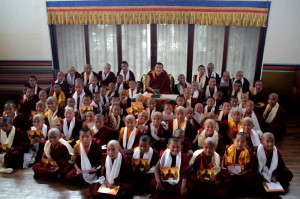 This year Shechen Monastery in Nepal admitted 60 young monks to the Elementary School division of the monastery. This brings the number of children under 14 years old being cared for by the monastery to 115!
This year Shechen Monastery in Nepal admitted 60 young monks to the Elementary School division of the monastery. This brings the number of children under 14 years old being cared for by the monastery to 115!
A majority of the new students come from remote regions of Nepal: Dolpo, Tamang, Sherpa and Mugum. They range in age from seven to thirteen. Their parents brought them to the monastery to receive an education that is lacking in remote areas. A few of the children came because they had their own wish to become monks. There are also three Bhutanese and one Tibetan child. ( You can sponsor a young monk)
These 60 are just a fraction of the number of monks applying to enter the monastery. The education and care they receive there is renown. All the children have undergone a thorough medical checkup and a personal interview.
Educating the young is an important function of the monastery. Many of the senior monks who teach and hold leading positions in the monastery arrived at Shechen as young children.
The education and training that the young boys receive here creates a strong base for their future studies and activities that we hope will eventually benefit the monastery. They are the key to the success and vitality in the future of the teachings.
Of course, the addition of so many additional children places an enormous strain on our finances and facilities. Thanks to a generous donor, we have built a wonderful and spacious school building to house the classes. However, new beds, furnishings, clothing, books and so on have to be purchased, in addition to the cost of daily food and medical help.
You can directly help to support these children by contributing to our sponsorship program. $250 (or donated monthly) via Paypal will help support one young monk annually. Please join us in educating and caring for these children now and in the future and become a sponsor. This is a rewarding and personal program and we hope you will become part of it. You can contribute at www.shechen/donate/sponsorship. Thank you so much.
Shechen Nuns Install Solar Panels
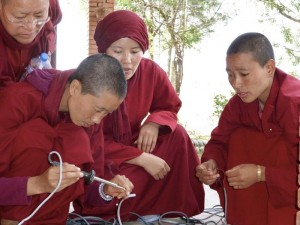 In 2012, under the auspices of Karuna-Shechen, four nuns from Shechen Orgyen Chodzong Nunnery in Bhutan trained to become solar engineers at the Barefoot College in India. They joined an international group of women training at the college.
In 2012, under the auspices of Karuna-Shechen, four nuns from Shechen Orgyen Chodzong Nunnery in Bhutan trained to become solar engineers at the Barefoot College in India. They joined an international group of women training at the college.
In March the nuns installed 100 sets of solar home lighting systems—40 sets at the Shechen retreat center in Namo Buddha, Nepal, and 60 sets in two nearby villages in the Banepa Valley. The nuns will be collaborating with a Nepali woman from one of the villages to set up a solar repair workshop and maintain the solar systems after the nuns leave It was a wonderful experience for the nuns to bring light to villages in need and to the retreat center. Their work is part of Shechen Rabjam Rinpoche’s initiative towards environmental sustainability that also includes the installation of rainwater harvesting in Shechen facilities.
The nuns have returned to their studies at the nunnery in Bhutan and will install solar systems as needed there. Our sponsorship program helps to support them in retreat and in their studies.
Mipham Transmission in Bodhgaya
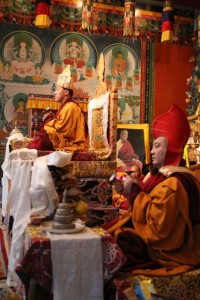 In February, at the request of the Ngagyur Kama Tradition Preservation Association (NKTPA) and others, Shechen Rabjam Rinpoche bestowed the entire transmission of the writings of Mipham Rinpoche at the Nyingma Monlam Temple complex in Bodhgaya. Mipham Rinpoche (1846-1912), a key figure in the Nyingma tradition of Tibetan Buddhism, was one of the most influential thinkers, writers, philosophers, and expounders of the Dharma of the last century. His writings cover a wide range of topics, including Buddhist philosophy, sutra, tantra, vinaya, astrology, and divination. They also include biographies, prayers, meditation instruction, and advice on the spiritual path. He was also one of the most famous expounders of the Rime (non-sectarian) movement in Tibet.
In February, at the request of the Ngagyur Kama Tradition Preservation Association (NKTPA) and others, Shechen Rabjam Rinpoche bestowed the entire transmission of the writings of Mipham Rinpoche at the Nyingma Monlam Temple complex in Bodhgaya. Mipham Rinpoche (1846-1912), a key figure in the Nyingma tradition of Tibetan Buddhism, was one of the most influential thinkers, writers, philosophers, and expounders of the Dharma of the last century. His writings cover a wide range of topics, including Buddhist philosophy, sutra, tantra, vinaya, astrology, and divination. They also include biographies, prayers, meditation instruction, and advice on the spiritual path. He was also one of the most famous expounders of the Rime (non-sectarian) movement in Tibet.
The transmission is comprised of more than 28 volumes of textual transmission of Mipham Rinpoche’s writings (lung), as well as the empowerments for his termas (dbang).
Dilgo Khyentse Yangsi Rinpoche and 2,800 people, including more than 500 tulkus, khenpos and lopons, attended the lung. The monasteries of Shechen, Namdroling, Mindroling and Dzongsar Shedra were represented along with Mindroling and Sissinang Nunneries. Attendees included all four orders of Tibetan Buddhism.
This is the first time this entire collection has been given since 1987 when Kyabje Dilgo Khyentse Rinpoche gave it in Namdroling Monastery in south India at the request of Penor Rinpoche. Shechen Rabjam Rinpoche received this transmission directly from Dilgo Khyentse Rinpoche.
The participants were extraordinarily blessed as the transmission also included a biography of Mipham Rinpoche that was written by Kyabje Dilgo Khyentse. It was written at a time when many of his disciples were still alive and is therefore considered to be very accurate and authentic. It was brought out of Tibet and given to Rabjam Rinpoche only last year. It was published and then distributed on the first day of this series of transmissions.
A six-day discussion of Mipham Rinpoche and his philosophy was also held with Rabjam Rinpoche and Khenchen Pema Sherab. Rabjam Rinpoche thanked the Indian government in a speech at an event applauding their support of the restoration and development of Bodhgaya.
Other Links:
Shechen Monastery offers an online prayer request service, please go to this link for more information or to request prayers: https://shechen.org/prayer-requests/
To make a donation or to sponsor a monk or nun, please go to: https://shechen.org/donate/
